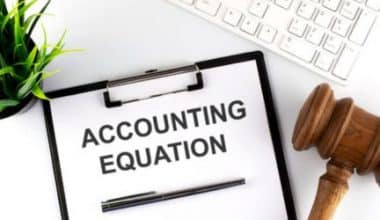Every reliable accounting system requires a thorough understanding of debits and credits. The difference between debit and credit accounting can be difficult to grasp while learning how to record or report business financial transactions. However, knowing the difference between the two entries in your financial statement book will help you better understand and keep track of your company’s financial health. This article will give an in-depth explanation of how to enter a business transaction using both debit and credit accounting entries, the differences between debit and credit accounting entries; examples; and ways to remember to use them.
Overview
Before delving into the specifics of the differences between debit and credit accounting, it is essential to have a firm grasp on how the two really interact with one another.
Contrary to single entry bookkeeping, which only affects one financial transaction’s value in either a positive or negative way, the rule in double-entry accounting:
- Maintains the accuracy of the ledger; every debit must match with a credit, and vice versa.
- Requires your two-sided debit and credit inputs must always equal each transaction.
Supposing money leaves your business because you need to buy new chairs for your staff, you’ll need to make a credit entry in your cash account. You’ll also have to account for a debit because you’re bringing in a new asset.
Nevertheless, to better understand your business operations, the double-entry accounting method is ideal.
What are Debits and Credits in Accounting
To put it simply, an accounting entry known as a debit, or “DR,” is one that increases a firm’s assets and decreases its liabilities. It can be described as any amount of money that enters a checking account. The debit entry is cited on the left side of the journal.
While credits are an accounting entry known as a credit (or “CR”), it is one that reduces assets and increases liabilities. One can think of credit as any money leaving an account. Furthermore, in most journals, the entry for giving credit is located on the right-hand side of the page.
One debit and one credit are required for every financial transaction, although there is no limit to the number of debits and credits that can be recorded. Also, each financial transaction is credited or debited according to the accounts listed in the company’s Chart of Accounts.
Accounts’ Debits and Credits Have an Effect On
These two classifications are a bit complex to understand as debits and credits have varying effects on various types of accounts. Let’s go over those accounts that debits and credits have an effect on.
They are the following
#1. Asset Accounts
Any account that falls under either the current asset or fixed asset accounts on the balance sheet is a company’s asset, such as inventories or accounts receivable. Credits decrease in asset accounts, while debits rise. Also, a negative entry is made in an accounting journal for any increases in assets. Credits are created when assets are reduced.
#2. Expense Accounts
Items on an income statement that are not directly attributable to the sale of an individual product are referred to as “expense accounts.” Most certainly, the list of expense accounts is often the longest on your chart of accounts. The range of costs, from payroll taxes to office supplies to advertising costs, is accounted for in expense accounts. And so, because you will have so many, it is absolutely necessary for you to develop the knowledge necessary to accurately record journal entries for them.
#3. Liability Accounts
Liabilities are the debts owed by the corporation to third parties. They might be short-term obligations, such as accounts payable and accruals, or long-term liabilities, such as bonds and mortgages payable.
#4. Equity Accounts
Like the liability accounts, the owner’s equity accounts are located on the right side of the balance sheet also. Retained earnings and common stock are two examples. When it comes to accounting journal entries, they’re considered equally to liability accounts.
#5. Income Accounts
The income statement includes revenue accounts. Profits from both cash and credit sales are typically included in the earnings of a business.
Investments can also be a source of revenue for a firm. Occasionally, larger corporations will make an investment in a smaller one. Marketable securities are short-term investments for smaller companies.
The Difference Between Debits and Credits in Accounting
Credits and debits accounting has two major differences which are the following:
- How they’re used in separate accounts (Functions)
- Where they appear in your journal entries (Placement)
Here’s a more in-depth breakdown of each difference.
Functions
The main distinction between debit and credit accounting is that they serve different purposes. A debit or credit will increase or decrease the balance depending on the account. The impact of each entry on different accounts is the following:
- Debit: Decreases liability, revenue, and equity accounts; increases asset and expense accounts.
- Credit: increases liability, revenue, and equity accounts and decreases asset and expenditure accounts
Placement
The placement of debits and credits on your journal entry is another critical difference between them. When entering a transaction, as a general guideline, use the following format:
- Credits: Usually on the right side of an entry
- Debits: Usually on the right side of an entry
How Do You Record Your Debits and Credits in Accounting
One way as well as the most popular way to record your debris and credits in accounting is the journal entry accounting
Journal Entry Accounting
Understanding business accounting journals is necessary for accurately entering your company’s debits and credits. Thus, A journal is a chronologically organized record of all accounting transactions. Hence, A journal entry is used by accountants to record activity.
Each journal entry includes debits and credits, which define where a certain cash amount is recorded. Your bookkeeper or accountant should be familiar with the several types of accounts that your company employs, as well as how to compute each debit and credit.
Using the T-account structure, you can see the debits and credits separately so that you can ensure they are in balance.
Each T-account is merely a visual depiction of a “T” in the form of an account. A debit or credit is recorded for each transaction in that account. The T-account can then be used to move this data to the accounting journal for recording.
Let’s see an example using debits and credits
Utility account ( expense account)
| Debits | Credits |
| Increases an expense account | Decreases an expense account |
| Received $750 | Paid |
Examples of How Debits and Credits in Counting Work
It’s important to note that when you pay a bill or make a purchase, you’re taking money out of one account and putting money into another one (value is received which is a credit). Using the chart below, you can determine whether to debit or credit a particular account.
| Increase | Decrease | |
| Assets | Debit | Credit |
| Liabilities | Credit | Debit |
| Shareholder’s Equity | Credit | Debit |
| Revenue | Credit | Debit |
| Expenses | Debit | Credit |
Examples of an Accounting Journal Entry Using Debits and Credits
Here are a few examples of how to use debits and credits in an accounting journal
Electricity bills for a company come in at $800 per month, Crediting your accounts payable account by $800 and debiting your utility cost account by $800. The following table is the accounting entry you’d create in your bookkeeping journal:
| Date | Account name | Debit | Credit |
| February 7 | Utility Expense | $800 | |
| Accounts payable | $800 |
Example 2
As a corporation prepares for the holiday season, it buys a significant amount of stock. Intangible assets such as inventory are paid in cash by the company. Inventories totaling $6,000 are procured by the company. This would be the format to enter for a journal entry:
| Date | Account Name | Debit | Credit |
| February 7 | Inventory | $6,000 | |
| Cash | $6,000 |
Example 3
We move on to the last debits and credits examples.
Purchaser A purchases $900 worth of goods from you with credit. This credit will increase your revenue account. In addition, It will increase your accounts receivable with a debit.
| Date | Account | Notes | Debit | Credit |
| June 13 | Accounts receivable | Sales to customers on credits | $900 | |
| Revenue | $900 |
How to Remember Debits and Credits
If you’re wondering, How to remember your debits and credits, these easy methods will help you settle the search in your mind
Because we are all unique, we require approaches that are tailored to our own demands. In this section, we’ll go through the three most effective ways to remember debits and credits.
These are the three top methods to remember your debits and credits:
- Hands Method
- DC ADE LER Method
- BS and P&L Method
#1. Hands Method
Accounting professionals all throughout the world benefit greatly using this approach. Most accountants agree that this is the most common approach.
The method is derived from the classical accounting equation which is the following
Starting with the fundamental accounting equation
Assets = Liabilities + Owners’ Equity (A = L + OE).
Next, determine owner’s equity
Owners’ Equity = Beginning Owners’ Equity + Net Income (OE = BOE + NI)
Next stage, net income = Net Income = Revenues – Expenses (NI = R – E)
Left Hand – Debits
All you have to remember in debits and credits is the left hand going up with two fingers pointing up (thumb and pinkie).
- Debit increases assets, as the pinkie points up.
- Debit reduces liabilities with the ring finger pointing down.
- With the middle finger pointing down, debit reduces the owner’s equity.
- Debit reduces revenue, with the index finger pointing downward.
- With the thumb pointing up; expenses rise as a result of the debit.
Right Hand – Credits
- Credit reduces assets, as the thumb points downward.
- Credit increases liabilities as the index finger points up.
- Credit increases Owner’s Equity with the middle finger pointing up.
- Credit increases revenue with the ring finger pointing up.
- Credit reduces expenses with the pinkie finger pointing down.
#2. DC ADE LER Method
There are several methods out there, but this one could be easy to remember when you need to.
All that is required in this situation is to memorize DC ADE LER and then write them out in the table below. The headers are DC from left to right. There’s an ADE and LER side by side in the left column.
| Debits | Credits |
| Assets | Liability |
| Draw | Equity |
| Expenses | Revenue |
Debits are always on the right, while credits are on the left. And consequently, both columns show a positive in the account.
#3. BS and P&L Method
This is probably the easiest approach, in my opinion. There is no room for error with this procedure, so once you master it, you will be able to do it without error. This technique makes the best use of your unique memory, which tells you that, on a balance sheet, the positions of revenue and expense are constantly shifting.
What’s More Important?
For every transaction, debits and credits must balance each other out as seen in the examples above. This fundamental principle must be grasped in order to avoid any confusion. To have an accurate general ledger, financial statements, and a clear idea of your company’s financial health, double-entry accounting requires that every transaction be accurately balanced.
Conclusion
When a company expands and the number of transactions increases, it becomes more difficult to keep track of which accounts to debit and which ones to credit. However, individuals had the time to hone their skills which means that you may do the same if you’re willing. If you put in the time, you’ll be able to learn all the ins and outs of debits and credits. Also, this essay has given you an excellent starting point for learning and understanding debits and credits with examples that you can follow.
FAQs
What is the rule for debits and credits?
The rules are the following First: Debit what comes in, Credit what goes out. Second: Debit all expenses and losses, and Credit all incomes and gains. Third: Debit the receiver, credit the giver.
What are the three types of accounting?
The 3 Different types of accounts in accounting are Real, Personal, and Nominal Accounts.
How do i Remember Debits and Credits?
There are three most common methods yhu can remember debits and credits which are the following: Hands Method, DC ADE LER Method, and BS and P&L Method
What is DR and CR?
Debit (DR) and credit (CR) both originate from Latin words. Debit is derived from the word debitum, which means “what is due,” and credit is derived from creditum, which means “something entrusted to another or a loan.” A credit to the account is a rise in liabilities or shareholders’ equity, denoted by the letter “CR.”






